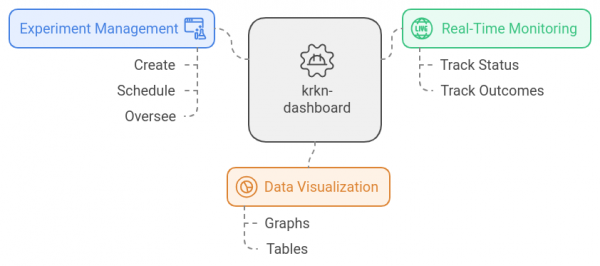In today's digital-first world, system resilience is not just a luxury, it's a necessity. Resiliency is a key differentiator in an era where downtime is expensive, and competition is fierce. It equips unexpected downtime, providing reliability and confidence to businesses and their users. A chaos dashboard is pivotal to chaos engineering by enabling teams to build, test, and improve overall system resilience.
Krkn is an open-source chaos engineering tool designed to enhance the resilience and performance of Kubernetes environments. By intentionally injecting failures into Kubernetes clusters, Krkn enables teams to identify vulnerabilities and ensure systems can withstand unexpected disruptions.
The Krkn chaos dashboard
The Krkn chaos dashboard is the visualization component of Krkn. It provides a centralized interface for designing, executing, and monitoring chaos experiments. It visually represents system metrics, experiment status, and resilience scores, enabling teams to assess system robustness and uncover vulnerabilities with Figure 1 showing the actual dashboard visualization.
Check out the project on GitHub.

How the krkn chaos dashboard enhances system resilience
The krkn chaos dashboard provides tools to inject, manage, and analyze failures of Kubernetes-based systems. It enhances system resilience as follows:
Simplifies chaos experimentation:
The dashboard offers a user-friendly interface for creating and managing chaos experiments without needing coding or YAML expertise. With just a few clicks, users can simulate failures like pod crashes, network disruptions, or CPU spikes.
Impact on Resilience: Encourages regular chaos testing by lowering technical barriers, helping teams identify vulnerabilities faster.
Real-Time system monitoring:
During chaos experiments, the dashboard provides real-time updates on system health metrics such as latency, error rates, and resource utilization.
Impact on Resilience: Enables quick detection of system weaknesses under stress, allowing for timely interventions.
Comprehensive reporting and analysis:
Generates detailed reports on the impact of failures, including system recovery times and failure propagation.
Impact on Resilience: Provides actionable insights, helping teams understand failure patterns and design better recovery mechanisms.
Facilitates fault injection across complex systems:
It supports a wide range of fault types, including network latency, disk failures, power outages, and node shutdowns. Allows targeting of specific namespaces, pods, or nodes within Kubernetes clusters.
Impact on Resilience: Simulates real-world failure scenarios, improving the system’s ability to handle diverse and unexpected issues.
Watch the following demo.
What’s next?
The future scope of Kraken lies in tying chaos and performance together where a simple benchmark runs to capture the performance data before injecting a failure, check how long it takes for the system to recover gracefully, and then run the benchmark again to find out if the failure has any impact on the performance of a specific component or on the system as a whole.
We are always looking for new ideas and enhancements to this project. Feel free to create issues on GitHub Krkn or open your own pull request for future improvements you would like to see.
